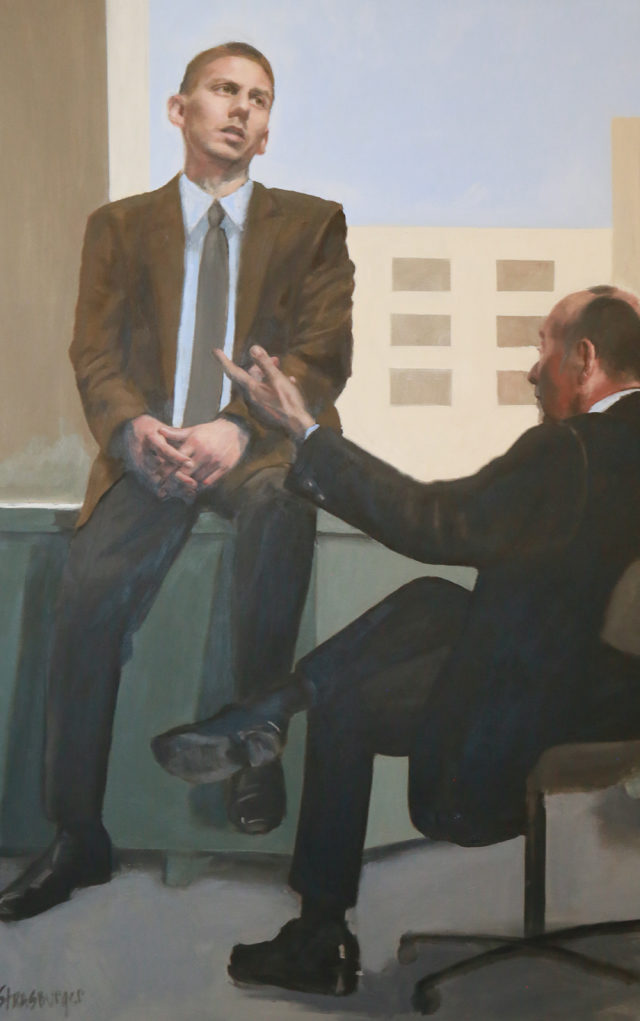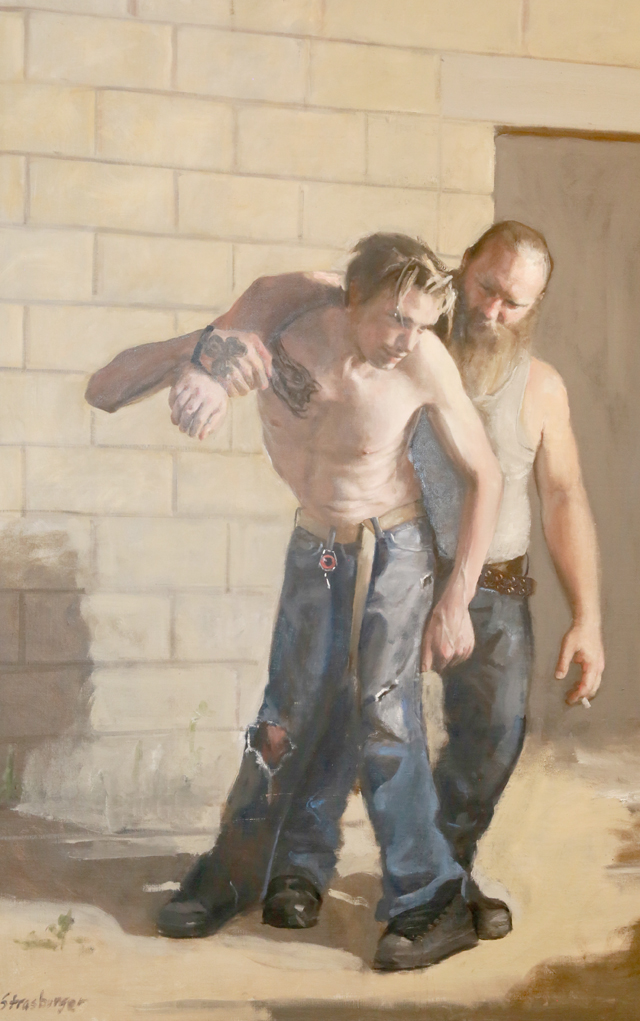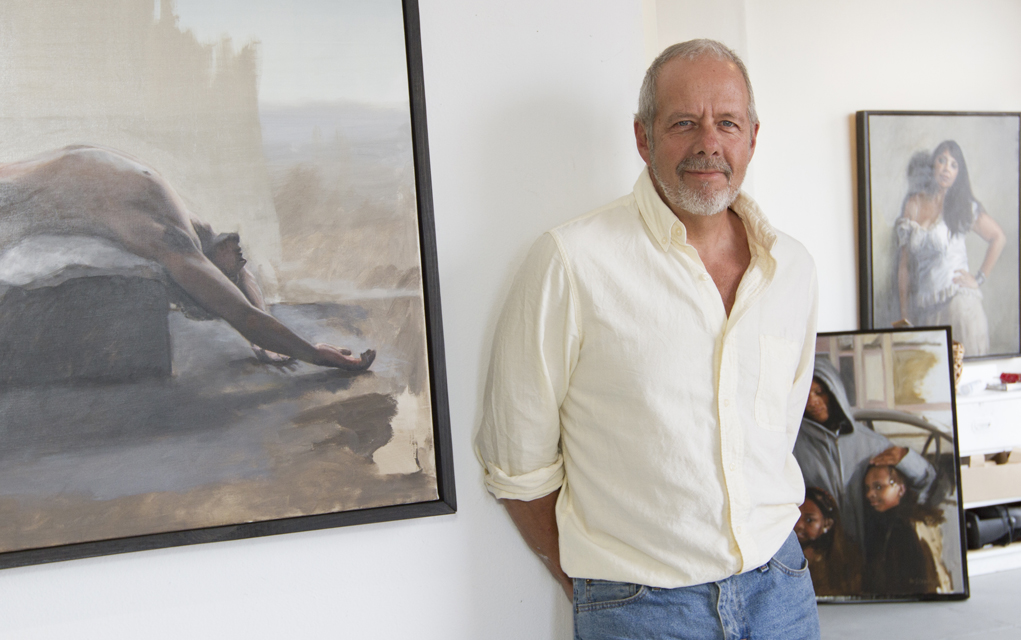
In George Strasburger’s painting “The Transaction,” two businessmen are talking in an office next to a big window. A man in a chair gestures to another man with a contemplative look on his face sitting on a desk. While the viewer has no real context of who these men are or what they’re talking about, the scene is heavy with possibilities — from the mundane to the bizarre.
“Someone was looking at that painting and she said the strangest thing. She shook her head and said, ‘Wow, he’s going to push him out the window.’ Which was like the furthest thing from my mind,” Strasburger says with a laugh.
Strasburger’s show, States of Men, now on display at The Dairy through Jan. 15, features multiple realistic paintings with one or more men in various situations, whether sitting on a curb or walking together in a group. Yet with the lack of visible plot, the viewer then is able to project their own thoughts on the work.
“That wasn’t intentional. I think that’s the nature of choosing scenes that are so unspecific,” says Strasburger. “It makes you think, ‘Where is the drama here?’ … I don’t think they’d be so dramatic had they been more typically dramatic. It’s something about the stillness and the commonality of the scene or the narrative that makes you think there’s something going on.”
For States of Men, Strasburger responded to a call for artists at The Dairy and his exhibit unfolded organically from there. He set out with no specific purpose or subject matter in mind. His only goal was to continue to improve his craft.
Strasburger started making art as a child, drawing portraits from baseball cards when he was 6 years old and taking painting class at 12. He took a break for a few years to pursue music, then got back in the art game by doing commissioned portraits. In the past five years, he’s committed himself to painting his own work.
His first exposure to art was in church and museums, seeing large-scale Biblical or historical scenes with many figures engaging with one another.
“For me, that seemed like an accomplishment for an artist to be able to do complex images,” he says. “And [the States of Men pieces] aren’t particularly large paintings or that complex, but to me they are. Because having done primarily posed portraits until [a few] years ago, this kind of interaction was attractive and challenging too.”
There’s a learning curve for Strasburger, but he realized he needed to push himself to create. In the beginning of his painting career, he says he spent too much time worrying about how important his work would be in terms of legacy.
“I had this romantic artistic notion that work is valuable if it can take a big place in history or if it has a big statement,” he says. “But that makes it hard. It made it hard for me. I would spend more time stewing about why I don’t have a vision than getting work done.”
So about five years ago, Strasburger gave up trying to force it and trusted his vision would come through.
“I don’t want to spend a lot of time sitting in my studio looking at a blank canvas thinking, ‘Why can’t I think of something?’ That’s a pretty distressing place to be,” he says.

So Strasburger let inspiration strike at will, and each painting in States of Men had a different catalyst. In “The Assist,” where one man leans on another for physical support, Strasburger got the idea from his own curiosity about strength — its variety and how it manifests.
The image of a physically weak man assisting a physically strong man intrigued Strasburger, saying it seemed like a metaphor, “We are all strong in different ways.”
He found a model in his next-door neighbor, who Strasburger describes as a brawny man with a beard. And when Strasburger said he was trying to find the weaker or smaller model, the neighbor suggested his friend, who happened to have cerebral palsy.
“I wasn’t intending to use a disabled person to make a statement about disability; it just happened to turn out that way that it was the actual situation,” he says.
“The big guy actually told me that there were many times where they’d be out drinking and they’d go to these heavy metal concerts. And the guy with palsy would help him get out of mosh pits when he drank too much. It ended up being a perfect example of what I was thinking.”
As an interesting coincidence, viewers often don’t know who’s helping whom in “The Assist,” Strasburger says. This added another layer to the painting, further questioning who can receive help versus who can’t, strong versus weak, young versus old.

In terms of models, Strasburger says he chooses people based on appearances that interest him. States of Men features young boys to older gentlemen. Strasburger is close to 60 and says that he gains insight when painting younger models.
“It helps me process in my own mind who it is to be an older person in a younger world. What do I have to offer? What do I no longer have to offer? … As we get older, I often hear that people my age or older start feeling invisible because younger people are more visible,” he says. “They’re given more presence or something. It preoccupies my mind when I’m working.”
At the onset, Strasburger didn’t set out to explore masculinity. One of his only goals was to portray various interplays. Although he’s married, Strasburger describes himself as a solitary person. So even more so, he’s interested in connections between characters.
In these painted scenarios, there’s vagueness in storyline but complexity in relationship. And it’s in this complexity where Strasburger started asking questions about manhood.
“I reflect on what does it take to be a man. What are men? Part of that is a gender thing — what are men as opposed to what are women? But it’s mostly what are men in terms of mankind?” he says. “What are we? What are we made of? What do we do?”
It was actually the lack of portraying a direct message or objective that guided Strasburger to create more meaningful work.
“Detaching myself from that intent, it made the result inadvertent and truer or more honest,” he says.

In “The Relationship,” a young guy sits on a cinder block in a backyard, while an older man hands him a lighter. Strasburger says people have interpreted this painting in many ways, from doing hard drugs to making Matrix references about “taking the blue pill.”
While Strasburger’s paintings are far from blank canvases, their ambiguity engages the viewer to create their own stories. The moments are loaded, and they can be good or bad, depending on whatever ideas the viewer comes up with.
“People read into them different things,” he says. “To me it’s just a good-natured interaction, and that’s often what they are, just simple good-natured interactions. But you know, we supply our own drama.”
Throughout the process of creating the show, Strasburger says he learned the value of these small moments.
“There’s a depth, maybe an existential depth to be found in every interaction. It’s not a scene of saving someone’s life or killing someone or doing a major historic thing. It’s just that simple stuff that contains that substance,” he says.
“I think it’s the wiser person who recognizes that and values that as opposed to thinking that their life is vacuous or a waste because there’s not some epic thing going on. Epic is where you find it.”
On the Bill: States of Men — George Strasburger. The Dairy Arts Center, 2590 Walnut St., Boulder, 303-440-7826. Through Jan. 15.














